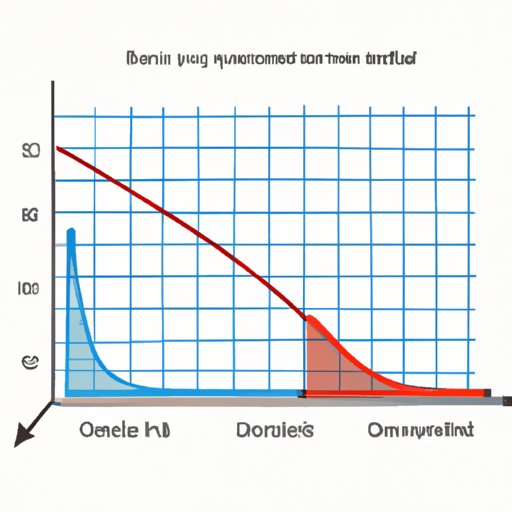
I. Introduction
Have you ever heard of Standard Deviation? It is a statistical measure that helps you understand the spread of data around the mean. This is a crucial concept in data analysis that can help you understand and make decisions based on research data. In this article, we will provide you with a comprehensive guide to understand the importance of Standard Deviation and how to calculate it.
II. Understanding Standard Deviation: A Beginner’s Guide
Standard Deviation is a measure that shows the amount of variation or dispersion in a set of data. This statistical term helps to indicate how much the data is spread apart from the average value or mean of the data set.
It is used to analyze the behavior of a set of data. Investors and researchers use this concept to understand the data set’s behavior and how often the series deviates from being average.
Let’s take a simple example to understand the Standard Deviation concept more clearly. Suppose we want to calculate the Standard Deviation of a student’s performance in the class. The mean score of the class is 70, and the Standard Deviation is 10. It would mean that most of the students scored between 60-80, and very few students scored less than 60 or more than 80 in their exam.
III. Masters of Variation: A Comprehensive Tutorial on Calculating Standard Deviation
Calculation of Standard Deviation can be done in various methods, like manual calculation or software.
To calculate Standard Deviation, you will first have to calculate the mean of the entire data set. Next, you will need to find the differences between each value and the mean of the set. These differences are then squared and added together. The sum of squares is divided by the total number of values in the data set minus 1, and the square root of the result is the Standard Deviation.
For example, if we want to calculate the Standard Deviation of a data set, we will need to follow the following steps:
1. Calculate the mean of the dataset
2. Find the difference between each value and the mean
3. Square the differences obtained in Step 2
4. Add the squared values obtained from step 3
5. Divide the sum of squares from step 4 by the total number of values in the data set – 1
6. Calculate the square root of the result from step 5
IV. Why You Should Care About Standard Deviation and How To Calculate it
Standard Deviation is a crucial aspect in data analysis and can help in various ways. It provides information on how well the data is clustered around the mean value.
If the Standard Deviation of the data is small, it means that the data is tightly clustered around the mean. Conversely, if the deviation is more significant, it means that the data is more spread out from the mean, indicating more significant differences in the data set.
There are a few tools and techniques that can help you use Standard Deviation in your everyday life, like budgeting your finances, analyzing sales data, tracking your personal fitness, and more.
V. From Mean to Deviation: A Step-by-Step Explanation of Standard Deviation
There is a relationship between mean and Standard Deviation. We can use the Central Limit Theorem to calculate Standard Deviation.
Central Limit Theorem states that if the sample size in a data set is large enough and randomly chosen, the mean distribution of the sample will be approximately equal to the population’s mean value. In this case, the Standard Deviation of the sample will become a standard error.
To calculate Standard Deviation using mean, we can follow the following steps:
1. Calculate the mean of the dataset
2. Find the difference between each value and the mean
3. Square the differences obtained in Step 2
4. Add the squared values obtained from step 3
5. Divide the sum of squares from step 4 by the total number of values in the data set
6. Calculate the square root of the result from step 5
VI. A Closer Look at Standard Deviation: Tips and Tricks to Improve Your Calculation Skills
There are several common mistakes beginners make while calculating Standard Deviation, like Incorrect formula usage, mixing up population and sample calculation, and incorrect summation of data.
To ensure accuracy while calculating, you should check your calculation carefully, be aware of the difference between population and sample calculations, and watch your summation for the dataset. Advanced tips and tricks for more complex data sets can be learned through practice and online resources.
VII. Standard Deviation for Data Analysis: How to Interpret and Use Standard Deviation in Your Research
Standard Deviation plays an important role in research, especially in social, health, and behavioral sciences. Researchers use Standard Deviation to understand how much variation exists in their samples.
It helps to determine whether results of a study are reliable enough to generalize to other populations or if the sample is too small or skewed. Researchers also use Standard Deviation to perform inferential statistical tests, like calculating confidence intervals and determining the statistical significance of results.
Best practices for using Standard Deviation in data analysis include careful data sorting and analysis, understanding the difference between population and sample calculations, and being aware of the data distribution.
VIII. Conclusion
In conclusion, Standard Deviation is a crucial concept in data analysis, and it is important to understand how to calculate it and interpret it correctly. From calculating the mean to learning tips and tricks for more complex data sets, this article has provided a comprehensive guide to understanding Standard Deviation.
We hope this article has been helpful in learning about Standard Deviation and its importance in data analysis. Remember to check your calculations carefully, pay attention to the difference between population and sample calculations, and enhance your analysis skills for more complex datasets.




